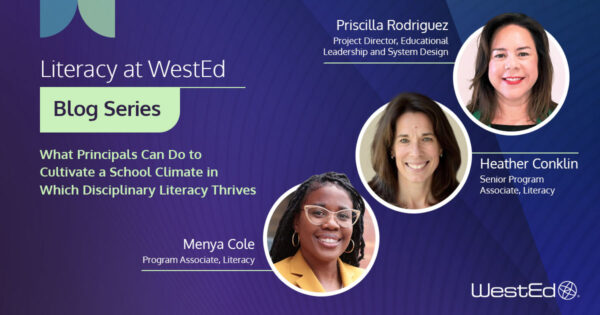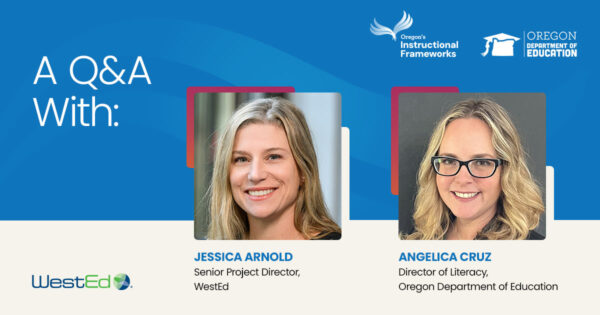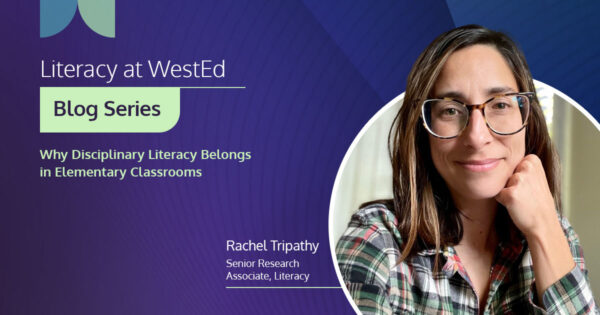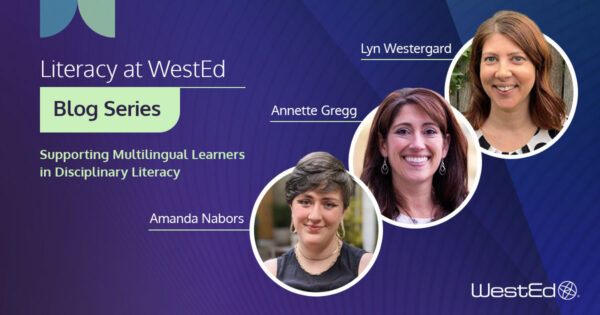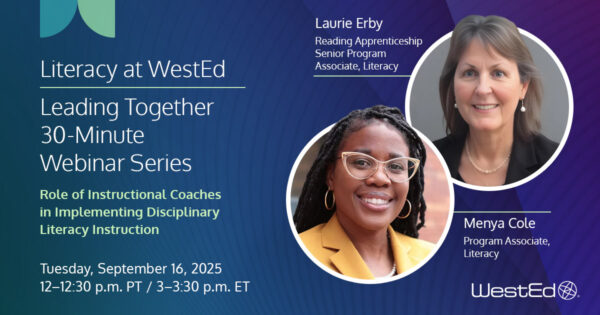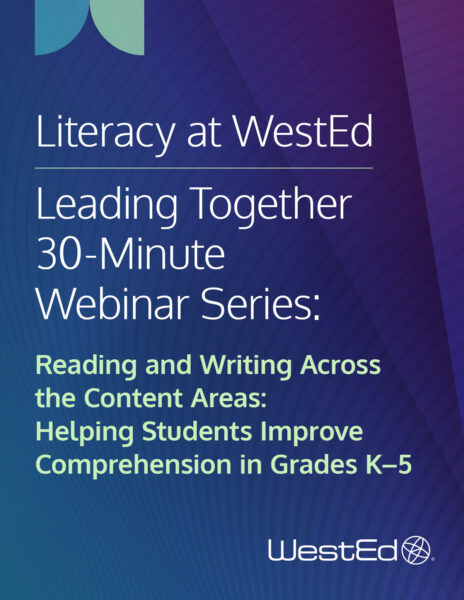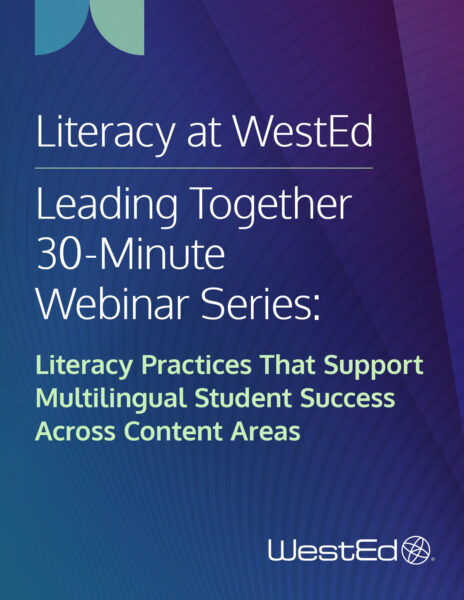
June 23, 2025
By Thomas Torre Gibney and Rachel Tripathy
This blog series explores the concept of disciplinary literacy—the distinct ways of reading, writing, and communicating across academic fields such as science, history, math, and literature. Featuring actionable insights from WestEd thought leaders, the series looks at how integrating disciplinary literacy practices into elementary and secondary classrooms can support student successes in school, careers, and throughout their lives.
Houston, Texas, is home to the Texas Medical Center, the largest biomedical research complex in the world and a hub for over 120,000 jobs at some of the nation’s premier hospitals and medical universities. Yet, despite the state’s status as a center for healthcare innovation, 224 of Texas’s 254 counties are designated as “health professional shortage areas,” affecting more than 6 million Texas residents.
Nationwide, there is a shortage of skilled workers in health science–related fields, even though these fields represent some of the fastest growing occupations in the country. Moreover, the trend is not restricted to the health sciences: Versions of this same story are found in many fields that require specialized, discipline-specific knowledge and skills. How can we get more students to see themselves in these jobs—and equip them with the knowledge and skills to thrive once they get there?
That question was at the center of the recent WestEd and Baylor College of Medicine (Baylor) cohosted convening on the importance of disciplinary literacy in science, technology, engineering, mathematics, and medicine (STEMM). Held on the Baylor campus in Houston, situated within that same biomedical research hub, the event challenged researchers and practitioners to contemplate the crucial role of disciplinary literacy skills in today’s STEMM fields.
The convening explored the current state of STEMM education in America, focusing on the gap between what is taught in schools and the ways in which scientists and medical professionals “do the work” of their disciplines. And while that work is rightly associated with a variety of quantitative reasoning skills, a lesser appreciated facet of STEMM learning has to do with the specialized literacy practices that characterize the day-to-day work of professionals in these fields.
Preparing Students for Success Across the Disciplines
For years, experts have recognized that learning to read is a foundational milestone on the path to success after high school. Even as students are learning the very basics of reading—phonemic awareness, phonics, fluency, vocabulary, and comprehension, known as the science of reading—literacy becomes a tool for accessing and assimilating new knowledge, unlocking deeper levels of engagement with a broader range of informational and fictional text.
As students move up the grade levels, they encounter text that is increasingly more complex and subject-specific. They learn to attend to the unique vocabularies, norms, and writing conventions of different disciplines. By the time they graduate high school, they must be prepared to apply what they’ve learned within the disciplinary contexts of their chosen postsecondary or career field.
Unfortunately, many students exit high school underprepared for the reading and writing demands they’ll face in college and in the workforce. According to the most recent National Assessment of Educational Progress (NAEP) data for high school seniors, only 37 percent of 12th grade students performed at or above the NAEP “Proficient” level in reading. This is troubling given that high school students’ ability to read complex texts is among the most reliable predictors of their performance in college, including in college math and science courses.
Even with additional postsecondary training, young people frequently lack the advanced literacy skills needed to succeed in today’s increasingly information-rich jobs. This challenge reflects more than just general reading ability. It highlights the need to develop students’ disciplinary literacy—the specialized ways of reading, writing, communicating, and thinking within specific fields. Mastering discipline-specific literacy practices is not merely an academic exercise but rather a fundamental requirement for success in higher education and the modern workplace, where professionals must interpret, analyze, and create specialized content within their fields.
What Is Disciplinary Literacy?
Disciplinary literacy refers to the unique ways that expert practitioners in a field read, write, communicate, and think. Disciplinary literacy is not at odds with the science of reading, nor does it represent a distinct, alternative approach to teaching students how to read. Rather, disciplinary literacy aligns with and extends the science of reading.
One example is the way in which students leverage metacognitive strategies when they read a poem, a news article, or a scientific report. Just as young readers do when encountering an unfamiliar word or sentence structure, students reading in disciplinary contexts monitor their comprehension, select appropriate strategies to improve their understanding, and reflect on their learning processes.
Beyond reflecting on one’s own thinking, students reading in disciplinary contexts are also interrogating the author’s purpose, paying attention to decisions as seemingly small as the choice to use one verb over another and decisions as overarching as the presentation and ordering of content in a text. Over time, they begin to recognize the lexical, syntactic, and organizational choices that govern the use of language in specific disciplines. When it comes to their own writing, they emulate these practices, using discipline-specific rhetorical devices and representations to communicate their ideas in a way that fellow practitioners in that field will recognize. In doing so, they’re applying critical thinking, problem-solving, and other cross-disciplinary skills that form the bedrock of so many of today’s fastest growing occupations.
Disciplinary literacy is also a social practice. As Dr. Elizabeth Birr Moje, dean of the University of Michigan School of Education and a leading expert on disciplinary literacy, explains in an AERA Ed-Talk, learning to read in a specific discipline—whether molecular biology or automobile repair—is like entering an entirely new culture. Each discipline has its own specialized language, texts, and ways of constructing meaning.
When you enter a new culture, she said, it takes time to learn the language and the rules of the culture. It really helps to have a cultural insider who can show you the way, who can help you navigate the language and the rules. It really, really helps to do the things that people in the culture do. So that’s what we need to do for our young people. They need to be engaged in the practices of the disciplines.
“It takes time to learn the language and the rules of the culture. It really helps to have a cultural insider who can show you the way, who can help you navigate the language and the rules. It really, really helps to do the things that people in the culture do. So that’s what we need to do for our young people. They need to be engaged in the practices of the disciplines.”
— Dr. Elizabeth Birr Moje
Dean of the University of Michigan School of Education
Disciplinary literacy is not just confined to STEMM careers. All professions, from historians and chemists to journalists and mathematicians, engage in a social process of making meaning from disciplinary text consistent with the practices of their expert peers in the same field. Comprehending, interpreting, and evaluating the text from a report on a psychology experiment looks different than engaging in the same practices with a work of fiction, for instance.
Disciplinary literacy provides a framework for engaging with complex text through the lens of how expert practitioners make sense of discipline-specific writing.
Why Disciplinary Literacy Matters Today
We live in a time of rapid social and economic change, as new tools like artificial intelligence (AI) challenge our traditional understanding of what it means to consume and produce knowledge. According to a 2024 survey from the Digital Education Council, 86 percent of students in higher education now use AI in their studies, with 54 percent using it on at least a weekly basis. For language arts specifically, the Lumina Foundation found that 66 percent of surveyed high school students are using AI tools. While these tools will likely be important in a variety of jobs, they can bypass the metacognitive processes essential for developing true disciplinary literacy.
Students’ reliance on AI for academic tasks creates a paradoxical situation: In an era when information is more accessible than ever, students’ ability to independently navigate, evaluate, and create disciplinary knowledge is at risk of diminishing. The consequences extend beyond academia into workforce readiness. According to a 2023 AAC&U employer survey, some of the skills most valued by employers are precisely those that disciplinary literacy develops: written communication (77%), critical thinking (79%), and complex problem-solving (74%).
While AI can be leveraged to support the application of discipline-specific skills, it cannot replace students’ ability to communicate critically and in specialized ways. As we navigate the complex relationship between AI tools and student literacy, a clear imperative emerges: We must double down on teaching strategies that help students develop the necessary skills to read and write in a variety of disciplines.
In disciplines like molecular biology, this might involve teaching students how to interpret nuanced statistical notation in research papers to evaluate methodological rigor and biological relevance. In the field of automobile repair, it might involve teaching students how to decode technical manuals and interpret diagnostic codes to apply the right solution to a mechanical failure.
Even as AI tools evolve, the ability to think critically and communicate within the norms of a discipline remains a distinctly human skill—one cultivated through meaningful learning experiences, not automation.
What’s Next for Disciplinary Literacy at WestEd
Building on the work of the WestEd–Baylor convening in Houston, we’re developing new research and professional learning services to enhance disciplinary literacy teaching and learning. Some of this work involves conducting original research to understand how different states are conceptualizing and implementing disciplinary literacy strategy in schools. We’re also assessing the current state of the empirical literature to identify effective disciplinary literacy interventions.
We’re expanding our established, evidence-based professional learning services, such as the following:
- Reading Apprenticeship emphasizes the “invisible work” that expert readers do when reading texts in their field. Through classroom routines like metacognitive conversations and think-alouds, teachers make these tacit processes visible to students.
- Our newly launched Writing Apprenticeship, modeled after the Reading Apprenticeship approach, helps students understand the disciplinary conventions and thinking processes that shape effective writing in different fields. Both Reading and Writing Apprenticeship position teachers as disciplinary literacy mentors who can model expert practices while gradually transferring responsibility to students.
- Making Sense of SCIENCE (MSS) professional learning courses focus on supporting STEMM teachers in their understanding and utilization of metacognitive routines to cultivate students’ disciplinary literacy. During MSS courses, teachers model and reflect on these metacognitive routines through literacy investigations designed to help students more effectively engage in productive scientific discourse.
Learning how to read and write like an expert helps cultivate the critical thinking skills valued in today’s economy. Schools and districts ready to strengthen their disciplinary literacy practices can start by reviewing their current curricula to identify where discipline-specific reading and writing instruction can be embedded. From there, teachers will need professional development that goes beyond generic literacy strategies, focusing instead on the unique ways knowledge is constructed and communicated in their subject areas. As educators navigate the challenge of preparing students for both college and careers, disciplinary literacy reminds us of the core function of literacy as a tool for deepening our engagement with the world around us.
Thomas Torre Gibney is a senior research associate in Literacy and the Center for Economic Mobility at WestEd. His research focuses on policies designed to help students navigate the path from education to careers.
Rachel Tripathy is a senior research associate in Literacy at WestEd, where she designs and manages studies of education programs and interventions, with particular expertise in early literacy development and reading policy.
